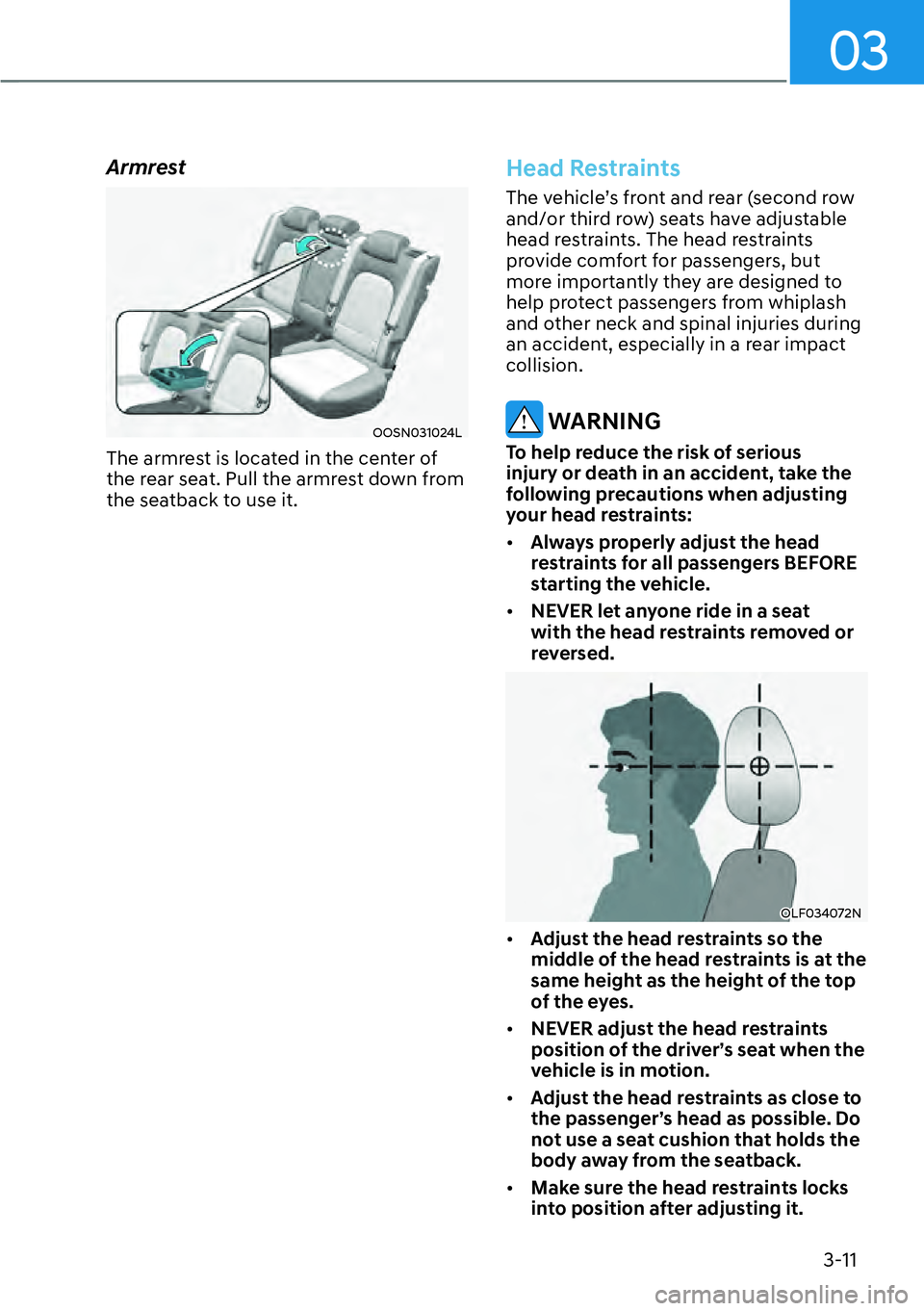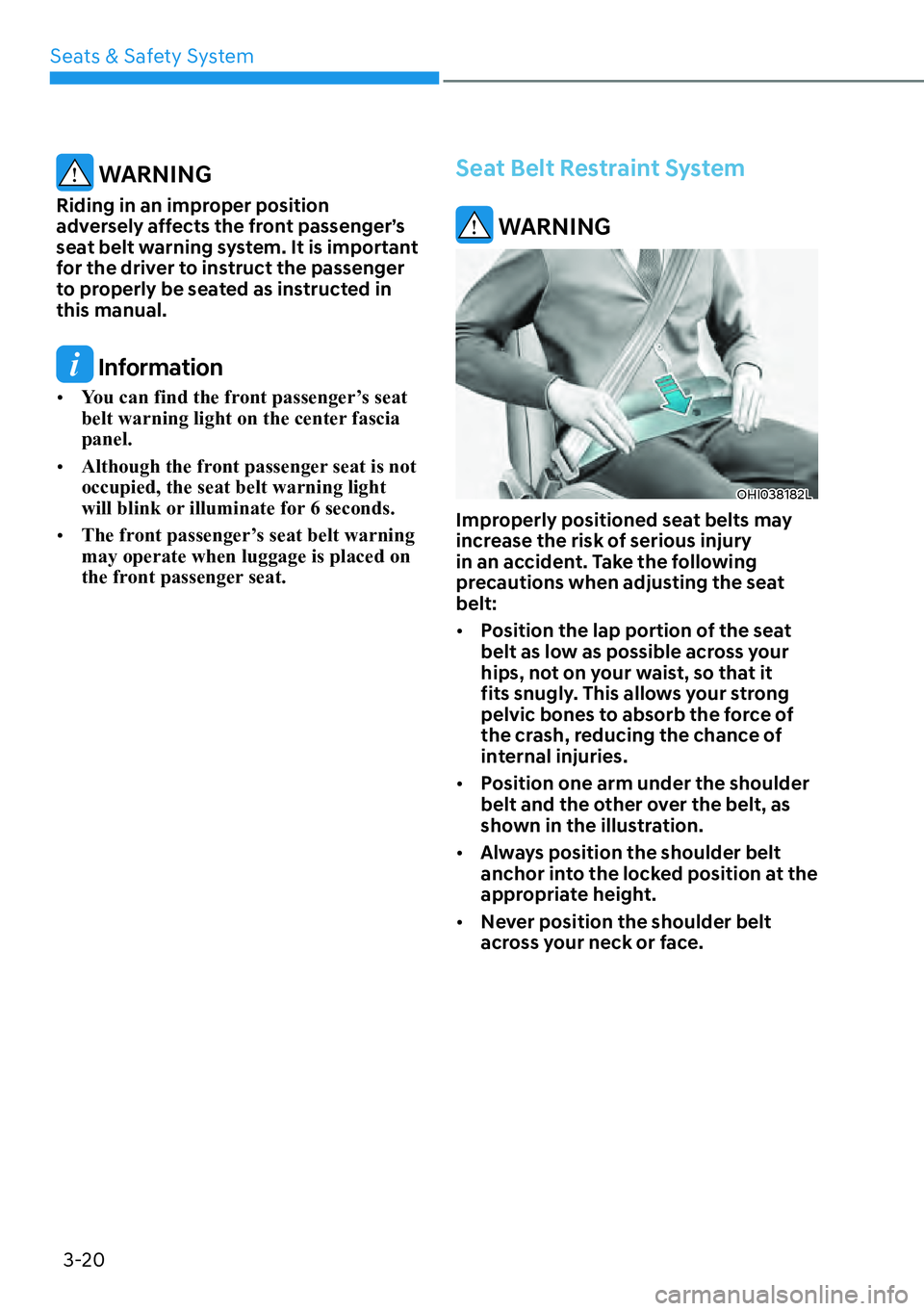Page 14 of 478
02
2-7
Itemsin. (mm)
Overall length 165.9 (4215)
O
verall width 70.86 (1800)
Overall height 61.02 (1550) / 61.61 (1565)*
1
Front tread235/40 R19 62.16 (1,579)
Rear tread 235/40 R19 62 (1,575)
Wheelbase 102.36 (2600)
*1 : with roof rack
ENGINE
Engine2.0 T-GDi
Displacement cu. in (
cc)121.9 cu.in (1998 cc)
Bore x Stroke in. (mm)3.39 X 3.39 in. (86.0 X 86.0 mm)
Firing order 1-3-4-2
No. of cylinders In-line 4 cylinder
DIMENSIONS
Page 26 of 478
3-3
03
Front seat
(1) Forward and rearward
(2) Seatback angle
(3) Seat height
(4) Lumbar support (Driver’s seat)*
(5) Seat warmer*
(6) Head restraintsRear seat
(7) Armrest*
(8) Seatback folding
(9) Head restraints
*: if equipped
SEATS
The information provided may differ depending on which functions are
applicable to your vehicle.
OOSN031101N
Page 30 of 478

03
3-7
Reclining seatback
Sitting in a reclined position when the
vehicle is in motion can be dangerous.
Even when buckled up, the protections
of your restraint system (seat belts and
air bags) is greatly reduced by reclining
your seatback.
WARNING
NEVER ride with a reclined seatback
when the vehicle is moving.
Riding with a reclined seatback
increases your chance of serious or fatal
injuries in the event of a collision or
sudden stop.
Driver and passengers should ALWAYS
sit well back in their seats, properly
belted, and with the seatbacks upright.
Seat belts must be snug against your
hips and chest to work properly. When
the seatback is reclined, the shoulder
belt cannot do its job because it will not
be snug against your chest. Instead,
it will be in front of you. During an
accident, you could be thrown into the
seat belt, causing neck or other injuries.
The more the seatback is reclined,
the greater chance the passenger’s
hips will slide under the lap belt or the
passenger’s neck will strike the shoulder
belt.OOSN031001L
Seat cushion tilt (1, if equipped)
To change the angle of the front part of
the sea
t cushion:
Push the front portion of the control
switch up to raise or down to lower the
front part of the seat cushion.
Release the switch once the seat reaches
the desired position.
Seat cushion height (2, if equipped)
To change the height of the seat cushion:
Push the r
ear portion of the control
switch up to raise or down to lower the
height of the seat cushion.
Release the switch once the seat reaches
the desired position.
Page 34 of 478

03
3-11
Armrest
OOSN031024L
The armrest is located in the center of
the rear seat. Pull the armrest down from
the seatback to use it.
Head Restraints
The vehicle’s front and rear (second row
and/or third row) seats have adjustable
head restraints. The head restraints
provide comfort for passengers, but
more importantly they are designed to
help protect passengers from whiplash
and other neck and spinal injuries during
an accident, especially in a rear impact
collision.
WARNING
To help reduce the risk of serious
injury or death in an accident, take the
following precautions when adjusting
your head restraints:
�[��Always properly adjust the head
restraints for all passengers BEFORE
starting the vehicle.
�[�� NEVER let anyone ride in a seat
with the head restraints removed or
reversed.
OLF034072N
�[��Adjust the head restraints so the
middle of the head restraints is at the
same height as the height of the top
of the eyes.
�[�� NEVER adjust the head restraints
position of the driver’s seat when the
vehicle is in motion.
�[�� Adjust the head restraints as close to
the passenger’s head as possible. Do
not use a seat cushion that holds the
body away from the seatback.
�[�� Make sure the head restraints locks
into position after adjusting it.
Page 35 of 478
Seats & Safety System3-12
CAUTION
When there is no occupant in the rear
seats, adjust the height of the head
restraints to the lowest position. The
rear seat head restraints can reduce the
visibility of the rear area.
NOTICE
To prevent damage, NEVER hit or pull
on the head restraints.
Front seat head restraints
OOSEV038012L
The driver’s and front passenger’s seats
are equipped with adjustable head
restraint for the passengers safety and
comfort.
OJSN038081
Adjusting the height up and down
To raise the head restraint:
1.
Pull it up to the desired position (1).
To lower the head restraint:
1. Push and hold the release button (2) on the head restraint support.
2. Lower the head restraint to the desired position (3).
Page 37 of 478
Seats & Safety System3-14
OOSN031100L
To reinstall the head restraint :
1. Recline the seatback.
2. Put the head restraint poles (2) into the holes while pressing the release
button (1).
3. Adjust the head restraint to the appropriate height.
4. Recline the seatback (4) with the seatback angle lever or switch (3).
WARNING
Always make sure the head restraint
locks into position after reinstalling and
adjusting it properly.
Rear seat head restraint
OOSEV038030L
The rear seats are equipped with head
restraint in all the seating positions for
the passenger’s safety and comfort.
CAUTION
�[��Adjust the headrests so the middle of
the head restraints is at the same
height as the height of the top of the
eyes.
�[��When seating on the rear seat, do
not adjust the height of the head
restraints to the lowest.
Page 38 of 478
03
3-15
OOS037018N
Adjusting the height up and down
To raise the head restraint:
1.
Pull it up to the desired position (1).
To lower the head restraint:
1. Push and hold the release button (2) on the head restraint support.
2. Lower the head restraint to the desired position (3).
OOSEV038029
Removal/Reinstallation
To remove the head restraint:
1.
Raise the head restraint as far as it can
go.
2. Press the head restraint release button (1) while pulling the headrest up (2).
To reinstall the head restraint:
1. Put the head restraint poles into the holes (3) while pressing the release
button (1).
2. Adjust the head restraint to the appropriate height.
Page 43 of 478

Seats & Safety System3-20
WARNING
Riding in an improper position
adversely affects the front passenger’s
seat belt warning system. It is important
for the driver to instruct the passenger
to properly be seated as instructed in
this manual.
Information
�[�� You can find the front passenger’s seat
belt warning light on the center fascia
panel.
�[�� Although the front passenger seat is not
occupied, the seat belt warning light
will blink or illuminate for 6 seconds.
�[�� The front passenger’s seat belt warning
may operate when luggage is placed on
the front passenger seat.
Seat Belt Restraint System
WARNING
OHI038182L
Improperly positioned seat belts may
increase the risk of serious injury
in an accident. Take the following
precautions when adjusting the seat
belt:
�[��Position the lap portion of the seat
belt as low as possible across your
hips, not on your waist, so that it
fits snugly. This allows your strong
pelvic bones to absorb the force of
the crash, reducing the chance of
internal injuries.
�[�� Position one arm under the shoulder
belt and the other over the belt, as
shown in the illustration.
�[�� Always position the shoulder belt
anchor into the locked position at the
appropriate height.
�[�� Never position the shoulder belt
across your neck or face.